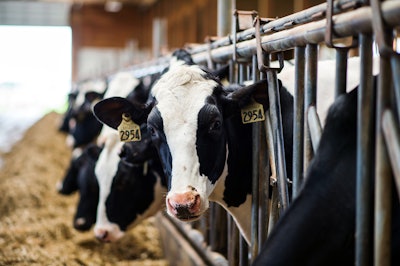Federal agencies announced on Friday financial assistance for dairy farmers to cooperate with government efforts to limit the spread of the H5N1 virus among dairy cows. The indemnity program announced by the U.S. Department of Agriculture (USDA) and the U.S. Department of Health and Human Services (HHS) provides up to $28,000 per farm to improve biosecurity, compensate for lost milk production, and protect against the potential spread of the virus between animals and humans.
After considerable effect on the agricultural poultry population, highly pathogenic avian influenza (HPAI) was found in late March among dairy cows in Texas and Kansas, where unpasteurized, clinical samples of milk from sick cattle at three different dairy farms tested positive after primarily older dairy cows were found with decreased lactation, low appetite, and other symptoms. Now, with cases among 42 herds in nine states (the list also includes Colorado, Idaho, Michigan, New Mexico, North Carolina, South Dakota, and Ohio), agriculture officials are struggling to stay ahead of the spread of the avian flu.
To help those efforts, the USDA is providing financial aid to dairy farmers in several forms:
- To protect against the potential for spread between human and animals, the agency will provide up to $2,000 per affected premises per month for producers who supply protective gear or outerwear to employees and also facilitate the participation of their workers in a workplace and farmworker study. Workers who participate in the study are also eligible for financial incentives.
- To support producers in biosecurity planning and implementation, up to $1,500 per affected premises will be provided to develop biosecurity plans based on existing secure milk supply plans. This includes recommended enhanced biosecurity for individuals that frequently move between dairy farms, such as milk haulers, veterinarians, feed trucks, and AI technicians.
- The agency will provide funding for heat treatment to dispose of milk in a biosecure fashion. If a producer establishes a system to heat treat all waste milk before disposal, USDA will pay the producer up to $2,000 per affected premises per month.
- Reimbursement for veterinarian costs associated with confirmed positive H5N1 premises can total up to $10,000 per affected premises. This can include veterinary fees and/or specific supplies needed for treatment and sample collection.
- To offset shipping costs for influenza A testing at laboratories in the National Animal Health Laboratory Network (NAHLN), up to $50 per shipment will be covered for up to two shipments per month for each affected premises. Such testing is already being done at no cost to the producer.
In all, these steps represent a value of up to $28,000 per premises to support increased biosecurity activities over the next 120 days. The USDA is also making $98 million in existing funds available to APHIS to fund further initiatives:
- The USDA is taking steps to make funding available from the Emergency Assistance for Livestock, Honey Bees, and Farm-raised Fish Program (ELAP) to compensate eligible producers with positive herds who experience loss of milk production. Though, unlike with poultry, there is little mortality associated with the disease related to cows, it does dramatically limit milk production, causing economic losses for producers with affected premises.
- Additionally, USDA will work with and support the actions of states with affected herds to help restrict movement and limit the spread of H5N1 between herds.
Preventing spread to people
Throwing another $101 million into the ring, HHS is focused on investments to mitigate the risk of H5N1 and continue its work to test, prevent, and treat H5N1.
A week after the USDA confirmed the initial outbreak among dairy cattle, a person with exposure to presumably infected cows in Texas also tested positive for the virus. Several barn cats have also contracted the virus and died at a Texas dairy farm where they had been fed raw milk from infected cows. The Centers for Disease Control and Prevention (CDC) still considers the risk from avian flu low for the general public, but is investing in making sure it stays that way.
HHS has put together a response team from four of its agencies—CDC, U.S. Food & Drug Administration (FDA), National Institutes of Health (NIH), and the Administration for Strategic Preparedness & Response (ASPR)—that is working closely with USDA to keep people healthy, safe, and informed; ensure that the food supply remains safe; safeguard U.S. agriculture and the livelihood of farmers and farm workers; and mitigate the spread of H5N1 among both people and animals.





















